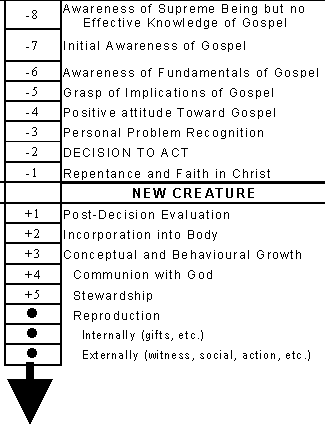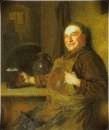The Engel Scale represents a continuum or “model of the spiritual decision-making process.” Developed by Dr James Engel, director of the Billy Graham graduate program in communications at the Wheaton College Graduate School, the chart depicts the stages one goes through in moving from a general awareness of a Supreme Being (-8), to grasping the implications of the Gospel (-5), to repentance and faith in Christ (-1), to an actively growing disciple (+3) and beyond.

I first encountered the chart in John Wimber’s Power Evangelism, and it’s stuck with me as a useful tool for understanding evangelism and discipleship. We must move people along the continuum, so to speak. But what does the Engel Scale have to do with Christian art?
The Bible teaches that salvation is both an event and a process. As such, everyone’s always in a different place spiritually. Being effective witnesses / ministers means learning to ratchet our approach to the listener’s level. Hammering away at John 3:16 can be frustrating if our “target audience” is not past Genesis 1:1. Making this even more fun is the fact that, amidst the varied cultures, traditions, and  personalities, God is constantly at work stirring hearts, bringing conviction, and orchestrating events. Recognizing where people are at — and where God’s at with those people — is integral to effective evangelism and discipleship.
personalities, God is constantly at work stirring hearts, bringing conviction, and orchestrating events. Recognizing where people are at — and where God’s at with those people — is integral to effective evangelism and discipleship.
When I think of Christian art (be it films, music, or literature), I think of it as existing on a similar continuum. Not only are Christian artists, at various stages of growth or ministry, sprinkled along the spectrum, their work (intentionally or unintentionally) connects with people differently. And this is a good thing. After all, somebody’s gotta go after the -8’s.
One of my issues with the current definitions and strictures of Christian art (especially as it relates to Christian fiction), is that large sections of this “artistic spectrum” are forced outside the camp. Whether it’s because of specific theology, semantics, cultural conservatism or a flat-out commercial hijacking, only the art that falls within certain parameters is deemed Christian. But perhaps the greater tragedy is that by narrowing the boundaries of the genre — which is what the Christian label forces us to do — we inadvertently diminish or overlook important expressions of Christian witness and ministry in the world.
I’ve been involved with small groups, leading them and training leaders, for over 20 years. A dilemma arose once when a small group under my watch decided to hold their Bible studies in a local pub. I thought it was a novel i dea! Until it was discovered that some individuals, as one is wont to do at a pub, enjoyed an occasional brew. Church officials immediately canned the group and an edict announced: No barroom Bible studies and absolutely no beer at small groups. Oh pah!
dea! Until it was discovered that some individuals, as one is wont to do at a pub, enjoyed an occasional brew. Church officials immediately canned the group and an edict announced: No barroom Bible studies and absolutely no beer at small groups. Oh pah!
Martin Luther once said: “It is better to think of church in the ale-house than to think of the ale-house in church.” But nowadays, thinking of the Church anywhere near an ale-house is liable to get you the boot. If someone’s gonna get saved, they’ll have to come to our house. Oh for the days when, like our Lord, the Christian was accused of being “a glutton and a drunkard” (Matt. 11:19); when stories and parables were unfolded before peasants and prostitutes, all under the watchful, disapproving eye of the religious gatekeepers.
The terms Christian art / fiction / music, indicate a retreat from the ale-house. We have our own thang now — something that reflects our values, our beliefs, our distinctives. The problem is, the people who need it must come to our place (see Christian bookstore) to get it. Where is the fiction that will reach the -8’s? Alas, it ain’t Christian and it can’t be found in our stores.
For the record: I have no problem with fiction that’s explicitly Christian, religiously conservative, aimed at church-goers, and unapologetically evangelistic. This type of fiction should exist! Why? Because there are people along the spectrum who need it. But when only that type of fiction is defined as Christian, I believe something is terribly wrong. As it stands now, Christian art has become the practice of speaking to the choir.
 To me, the one defining factor of Christian art is the author — are they a genuine believer? We have reason to question the Christian artist whose work is incessantly dark, overly graphic, intentionally erotic, or lacks any representation of biblical theme or virtue. If one is really saved, their work (and life) should stand up under questioning. However, many of those who are asking the questions also hold the purse strings and are, therefore, free to make the rules.
To me, the one defining factor of Christian art is the author — are they a genuine believer? We have reason to question the Christian artist whose work is incessantly dark, overly graphic, intentionally erotic, or lacks any representation of biblical theme or virtue. If one is really saved, their work (and life) should stand up under questioning. However, many of those who are asking the questions also hold the purse strings and are, therefore, free to make the rules.
In the end, I’m a Christian and I write fiction. That fiction will fall at various points along the spectrum — from overtly biblical to not so much. So is it Christian? Hmm. You got me.















Mike, that crosses over into so many areas in the church. And as “we” continue to focus inward, we look no different than those “outside.”
Keep pushing … I believe you’re going to be instrumental in changing that.
I’ve really appreciated this series, Mike. You’ve raised good questions and provided food for thought. Sometimes I write stories that are overtly Christian in content, but sometimes I write stories that aren’t. But I hope that all of them in some way reflect God at work in me.
Well, I tried doing a trackback, Mike, but I can’t seem to make that work consistently. At any rate, instead of writing a long comment here, I interacted with your ideas in my post today. Thanks for giving good material to stir discussion.
Becky
As you would probably guess, Mike, I completely disagree with you.
CHRISTian art should have Christ at its center. That is not to say that art by christians doesn’t have intrinsic value. Quite the contrary, they may indeed accomplish the goal of the early stages of the chart. But art that introduces the idea of a supreme being is not Christian by definition unless it relates the story of Christ Jesus. The belief in a supreme being is not a Christian-only phenomenon. Therefore, there must be a label to distinguish.
Art by artists who are Christians should only be labeled Christian art at the discretion of the artist and the beholder.
Christian art by Christian artists should be Christ-centered and self-evident. It is a declaration of the intentions of the artist.
I am a Christian writer. I embrace that label. It means that my writing will be Christ-centered. Again, it’s a declaration of responsibility and a forgoing of my own desires to the will of God. A statement of intent to my future readers.
For me personally, I would rather be remembered as a Christian writer than simply a writer. I know it’s not for everyone. That’s why we need the label to distinguish.
To those who want to be writers who happen to be Christian: GOD BLESS YOU!!! You may do more for the kingdom of God than I ever will.
But, I am not convinced that there is any great potential for evangelical outreach in Christian fiction. The Christian worldview novels tend to be too generic for true outreach and the Christian novels are in the Christian section where Christians are shopping. I also believe that the ministerial component is greatly underappreciated and underestimated by the authors who wish their work to be a missionary outreach. What’s wrong with ministering to the faithful? Pastors do it everyday.
I welcome any thoughts and GOD bless you and your writing Mike.
thanks, dayle
*** by the way, MIke. Although we often disagree, I do admire your writing ability. I could easily see you as a columnist for a major magazine or newspaper. Your arguments are well though-out and well sourced. I’m glad you’re on our side.
Hey Dad,
You’re my favorite Christian author!
dayle, you make some great points. Some rapid-fire responses:
dayle: “CHRISTian art should have Christ at its center.”
md: Says who? Did the story of the Prodigal Son, the Good Samaritan, or the Unjust Judge? Only by inference. The Book of Esther does not even mention God — does that make it unChristian?
dayle: “…art that introduces the idea of a supreme being is not Christian by definition unless it relates the story of Christ Jesus.”
md: Says who? Belief in God must, of necessity, precede belief in Christ. The right path always has a beginning, and this is Christianity’s. Likewise, monotheism (belief in ONE God), defines Christianity. The foundations, though unseen, are essential to the integrity of the structure.
dayle: “Christian art by Christian artists should be Christ-centered and self-evident.”
md: Says who? I think Christian art by Christian artists could be much broader and more nuanced. But the fact is, you and I are not the ones defining the genre. It is the industry that endorses or rejects what we offer.
Once again, I greatly appreciate the spirit of your dialog, dayle. God’s grace and mercy to you, my brother!
Good points Mike, However
Whatever Jesus says or does is Christian by definition– He is Christ.
consider this example:
I paint oil paintings. I’m a Christian. If I paint a painting of a soup can, that painting is not Christian art because I’m a Christian. It’s a soup can. Sure, I can come up with some convoluted set of rationalizations and circular logic to try to make it Christian, but I would still be incorrect.
-dayle
GerM, being separate from the world does not mean isolation. The religious of Jesus’ day believed that holiness required distance — you could not touch or interact with the unclean without becoming defiled. So when Jesus befriended the outcasts — tax collectors, lepers, prostitutes — the natural conclusion was that He was a sinner. But going into a bar does not makes a man any more a sinner than going into a church makes one a saint.